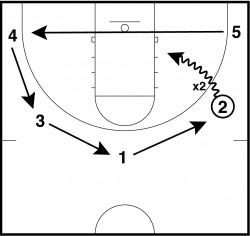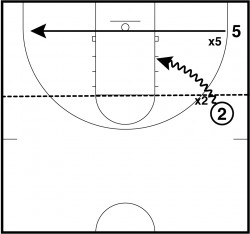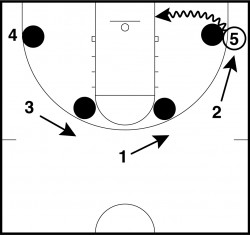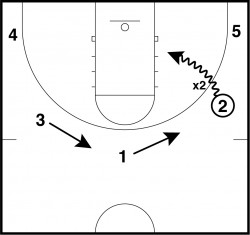I love the corner cutter in a 5 OUT when the wing drives baseline. There, I said it. It’s out there and it feels so good to get that off my chest.
Why do I love him?
Well, mainly because he is the underdog. He is the most harassed cutter in the entire Read & React system, yet he continues to soldier on, following the Circle Movement principle with a blatant disregard for what outsiders might think of him.
“You’ll clog the middle!”, they yell.
“You won’t make it to the other side in time!”
“You’ll keep the penetrator from getting to the rim, you selfish…”
But, those words of discouragement don’t even phase him. He just Circle Moves like he’s been trained to. Sometimes he’s open; sometimes not, but he knows deep down that he’s doing what’s best for the big picture.
Nicely done, corner cutter in a 5 OUT when the wing drives baseline. Nicely done.
Ok, that’s over. I just had to have a little fun with this issue. In reality, this is probably the most discussed “problem” in the Read and React. We’ve had emails about it, I’ve seen it in forums, coaches ask about it in clinics and I finally want to put it to bed (at least, for now).
The goal of this post is to look at what aspects of this action are seen as problems and examine all the proposed solutions. From there, it’s really up to you.
The Perceived Problem (Yes, I said, perceived)
First, let’s make sure everyone is on the same page by explaining the situation.
In the Circle Movement Dribble Penetration layer, the broad rule is this: if a player drives right, his teammates Circle Move one spot to the right. If a player drives left, the other players Circle Move one spot to the left.

Some coaches find that there is not enough space for both of those players (2 & 5) to coexist. They’ve either seen this in practice or it doesn’t make sense on paper. But, ultimately, that’s the issue.
2 Solutions: 3 Crutches
Over the past 3 years, we’ve come across 5 options for dealing with the corner cutter when the wing drives baseline. In reality, though, there’s 2 solutions and 3 crutches.
Solutions
- Train the habit more. I like this one because it sounds so smug, but this really is your best option.
- Discuss Intelligent Drives with your team.
Train the Habit More
The main reason why coaches struggle with the corner cutter is that they don’t give it enough training time. They’ll put in Circle Movement, run it through in practice, and inevitably the wing will drive baseline and the cutter won’t make it through in time.
That is not the time to assume the corner cutter is flawed and the system doesn’t work. It doesn’t work yet. Why? Because your players haven’t been trained to see that first dribble and react instantly by habit. They are still thinking about cutting. This is not a comprehension problem, it is a muscle memory problem. And the only solution is more training.
If the cutter leaves too late, the cut won’t work. If the cutter doesn’t cut with a purpose, the cut won’t work. Both of these problems can be solved with more training (or, maybe with a sub 🙂 ).
Intelligent Drives
Just because the ball handler has the freedom to do anything he wants in the Read & React doesn’t mean every action is an intelligent one. There may be no better example than the corner cutter.

In fact, with this spacing, a determined North-South drive, and a hard corner cut, we are forcing x5 to make a difficult decision: help on the drive and leave 5 open for the dish or stay with 5 on the cut and leave x2 without any help. My money is on the offense either way.

This is a situation where you should tell your players that if the spacing is not there, the baseline drive from the wing position is not a viable option.
Crutches
A crutch is a tool used to assist you on your way to mastery. For some teams, you’ll never need a crutch. For others, you’ll use it for the first month or the first year before letting it go. And, for other teams, you’ll always use the crutch. Any of those choices are ok. You know your team better than we ever could. You know what they are capable of and where you should concentrate your time.
By the way, each of the following options violates the Circle Movement habit (even if it’s just a little bit) that your players already know. This means that they’ll have to think and thinking slows reaction time. That’s why these are crutches in my book and not solutions.
- Apply the Baseline Drive rules to this scenario.
- Cutter remains in the corner during the drive. This is similar to #2.
- Corner cuts baseline before the drive. There are two options for this.
Crutch #1: Apply Baseline Drive Rules to the Wing Drive Baseline

If these rules are applied to the Wing Drive Baseline situation, then 5 would stay in the corner (no cut at all) as the Safety Valve, 4 would stay in the corner as the Natural Pitch, and 1 and 3 would shorten their Circle Movement to fill the 90° and 45° areas respectively.
The advantage of this option is that if you have already put in the Baseline Drive layer, then your players are already familiar with these habits, you just have to train them that these rules apply to any drive to the baseline, regardless from which spot it originated.
Now, remember that situation from the Intelligent Drives section where the corner cut forces x5 to make a difficult, no-win decision? That’s what you lose by keeping the 5 as the Safety Valve rather than having him cut.
Plus, you lose the 5-player movement since two of your players (those in the corners) are standing still.
I will warn you of this: if you go this route, it will most likely be a permanent decision. Once you’ve taught your players that all Baseline Drives are treated the same, it will be extremely difficult to unteach that habit.
Crutch #2: Cutter Remains in the Corner
This is similar to Crutch #2, but instead of having the entire team treat the drive like a Baseline Drive, you just instruct the ball-side corner to remain in the corner during the drive. Everyone else should Circle Move as normal.

But, the real problem with this option is that it teaches the corner player a habit that is not taught anywhere else in the system. Standing in the corner violates the Circle Movement habit and again forces that player to think and make a decision, “Do I cut or do I stay?” This may slow his reaction time down in a situation when he’s not in the corner or when the wing drives middle and the answer is, “Circle Move!”.
Clearly, teams and players with higher basketball IQs may not find a problem with this inconsistency, but it may wreak havoc on a younger or more inexperienced team.
Crutch #3: Corner Cuts Baseline Before the Drive
In this option, the corner cuts baseline prior to the drive from the wing. This can happen on a variety of cues, but the two that come up most frequently are:
- corner cuts immediately after the wing catches the ball.
- corner cuts if the wing waves him through.
Of these, I prefer the wing waving the corner through. This should only be done, however, if the wing really wants to drive baseline – maybe that’s his strong hand or maybe he sees something in the defense that he can exploit. Regardless, this wave through should be done for a reason, not just because coach said it was ok.
If this cut before the drive is done immediately after the wing catches the ball or if it is done after a negligent wave through, the ball handler loses all of his East-West options toward that corner – pass, power dribble, speed dribble. And, if the wing ends up driving middle instead, he is left with no Safety Valve. That seems a little too limiting to me.
Also, with the wave through, you aren’t really violating any read habits since in this situation the corner isn’t reacting to the ball, he’s reacting to a teammate’s signal. I mean, I don’t really care what offense you are running, if a teammate is looking at you and waving his hand to go away, you should defer to that decision. That’s just common sense.
Can’t the Cutter Stop in the Short Corner?
For the specific situation that we are dealing with in this post (5 OUT, wing drives baseline), I don’t see stopping in the short corner as a viable option. Think about it, the ball-side short corner is extremely close to where the penetrator is heading. The cutter will be bringing his defender to the ball, then stop being a threat to the goal which will effectively let the defender help without consequences.
Now, let me be clear because the short corner is a viable crutch for the baseline cutter for almost any other penetration:
- either corner drives middle.
- either wing drives middle.
- point drives either direction.
Why is it ok for these drives, but not when the wing drives baseline?
Good question.
Since the short corner is a Post Slide spot, let’s look at it from a 4 OUT perspective.
The Basic Post Slide layer states that if penetration comes above the post, the post must slide down into the short corner. Conversely, if penetration comes below the post, the post must slide up the lane to the elbow.
If a corner drives middle, a wing drives middle, or the point drives, the penetration is coming from above the post; therefore, the post must slide to the short corner. That means the short corner is a familiar Read & React spot for any of those drives, even if we remove the post and go back to 5 OUT.
If the wing drives baseline in a 4 OUT, however, the penetration is coming from below the post and he must slide up the lane to the elbow. That means the elbow is the familiar Read & React spot for that drive, not the short corner. So, when we go back to the 5 OUT and the wing drives baseline, not only is the spacing bad for the cutter to stop in the short corner, but it is also puts him in an unfamiliar spot for that particular drive.
So, if you must use the short corner as a crutch for your other drives, don’t use it for the wing drives baseline. It probably won’t work out in your favor.
And if you do use it for your other drives, please remember this. As reaction times speed up, the cutter should be getting farther and farther through the cut before the penetrator reaches the lane until eventually you can throw this crutch away. Or, maybe put it in the attic since that seems to be where all crutches go to die anyway.
Suggestions
The Read & React is an Operating System. How you operate the Read & React will depend on your talent or lack thereof, your opponents, and your own coaching philosophy. These are the things that influence whether you play 3 OUT 2 IN or whether your offense has a screen in every action, or whether you take a shot in the first 7 seconds or whether you use the entire shot clock. These are the things that will also dictate which of the above crutches you will use (if any).
The Read & React allows for flexibility and adaptability, but it doesn’t determine it – you the coach will determine those types of things. Ultimately, you know your players. You know your philosophy. You know your opponents. And every decision you make in how to implement the Read & React should take that knowledge into consideration.
If it were my team, though, I’d skip the crutches and just drill more! What I might lose occasionally by sticking to Circle Movement in this situation, (and I’m not sure that I concede that anything is lost if a team will simply practice it more and emphasize the right spacing), I gain much more due to the simplicity of “one rule for all situations”; when it comes to training players to be decisive and aggressive, less is truly more.
But what about you? Has this action been a problem for you? Have these crutches worked for your team? Have I missed any? Tell us your thoughts Read & React coaches and help those coaches who might be struggling.







